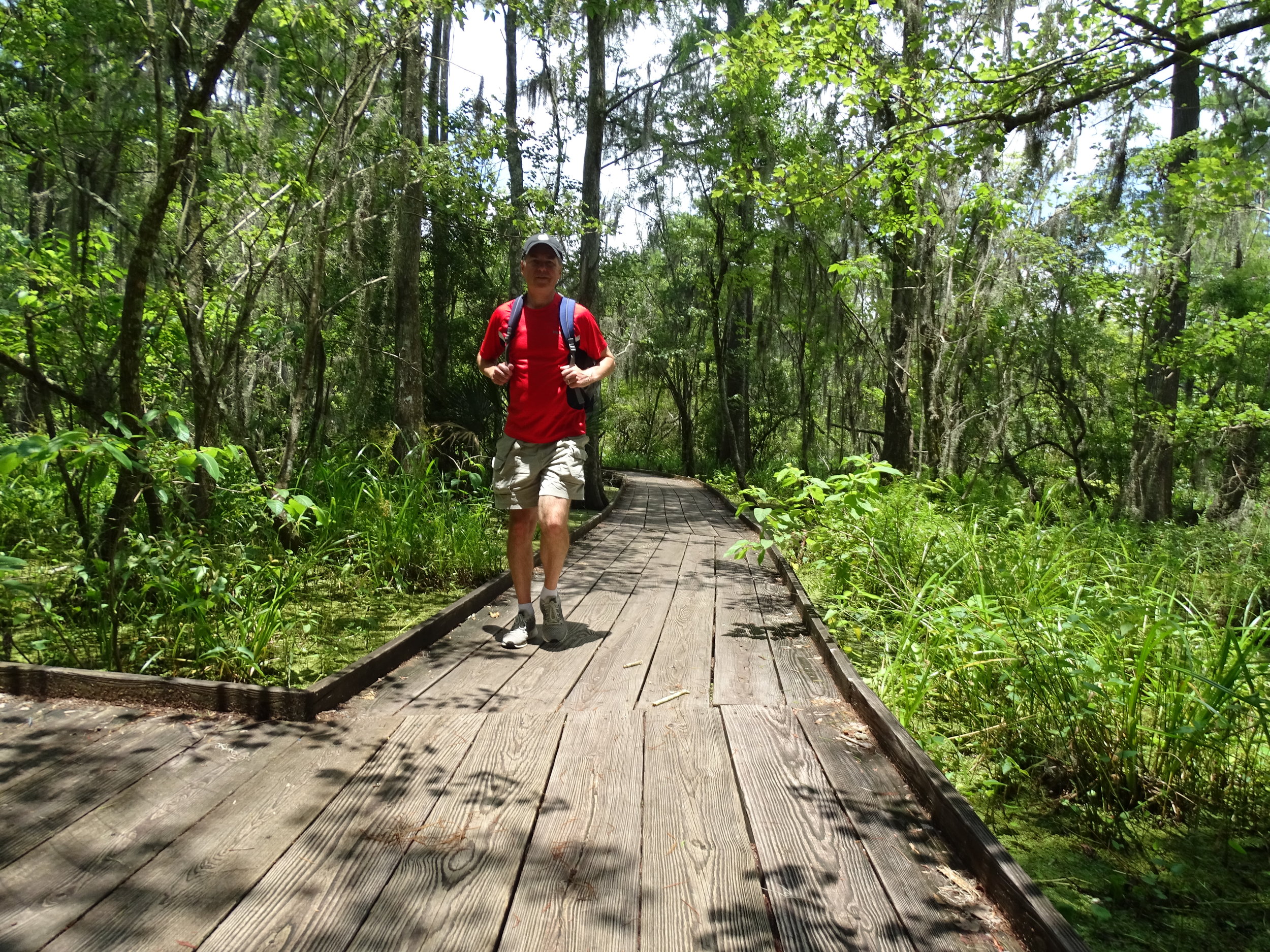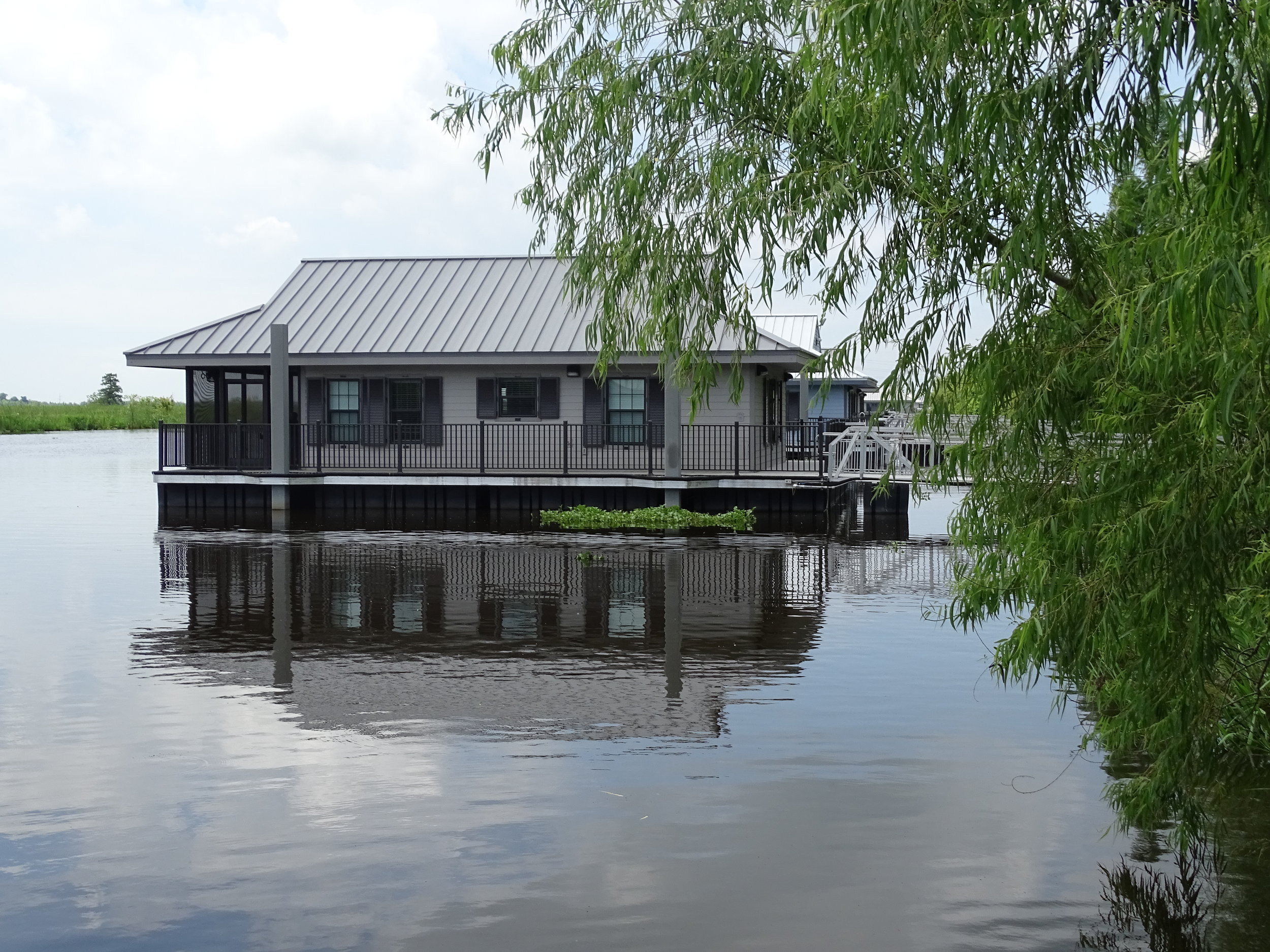Louisiana: Great Places to Visit Swamps near New Orleans
The boardwalks at the Barataria Preserve provide a pleasant stroll through a classic Louisiana swamp.
Louisiana’s Mississippi River Delta includes the night life and fine dining of New Orleans, but you don’t need to go far out of the city to discover places of natural beauty. Take the Pontchartrain Expressway (Business Route 90) out of New Orleans to the West Bank if you’d like to get a sense for the delta’s unique look and to learn about the evolving land. These great locations to visit include the Barataria Preserve in Marrero and Bayou Segnette State Park in Westwego. In good traffic, they’re both about 30 minutes from New Orleans and well worth the drive.
Doug hikes the Palmetto Trail at the Barataria Preserve.
BARATARIA PRESERVE
The Barataria Preserve features 24,000 acres of marsh, swamp and hardwood forest. It is part of the Jean Lafitte National Historical Park and Preserve operated by the National Park Service. It offers a great way to experience nature in the Mississippi River Delta through walking trails and includes a visitor center, environmental education center and ranger programs to expand your understanding.
Walkers and hikers have many options at the preserve. The most popular at only .25-mile one-way is the Visitor Center Trail. It’s a boardwalk trail that features a circular bench under a baldcypress tree near the start of the trail (at the visitor center) and has a freshwater marsh view at trail’s end.
The Palmetto Trail, .9-mile one way, is the next choice for most visitors. It’s also a boardwalk trail and starts at the visitor center. You’ll get a great view of the diverse vegetation in the area, including many dwarf palmetto plants.
Linda takes a break at the head of the Visitor Center Trail.
Other trails that include boardwalks and gravel surfaces are the Bayou Coquille Trail (.5-mile one way), Marsh Overlook Trail (.4-mile one way), and Ring Levee Trail (.6-mile one way).
Hiking trails are also available, but they are muddy and might be impassable in rainy periods. In case you don’t know New Orleans weather, it often rains, so be warned about these trails. They include:
Wood Duck Trail (.4-mile one way) to see hardwood forest, ponds and forest birds
Plantation Trail (two loop options that are 1.8 miles and 1.4 miles for the round trip) to see giant live oaks, remnants of irrigation ditches from plantation and farming day, deer and armadillos
Old Barataria Trail (1.4 miles round trip) to see varied habitats and dwarf palmetto plants
Twin Canals (.6-mile one way) to see a hardwood forest, small footbridge and canals
Stop at the visitor center to get a trail map and to discuss the options with a staff member there. You’ll get good information about current conditions of the trails and where to access them. The preserve delivers amazing natural beauty at nearly every bend in the trail, so you won’t find them boring walks or hikes and you’ll need a camera. Another option is to bring a canoe. There preserve includes three places to launch a canoe.
A snowy egret stands guard at the boat launch at Bayou Segnette State Park.
BAYOU SEGNETTE STATE PARK
Bayou Segnette State Park attracts a wide range of visitors.
Boaters use the bayou to access Lake Cataouatche and Lake Salvador for fishing or boating
Campers stay in the campground
Families enjoy the wave pool, playground and picnic areas
Hikers explore the four trails at the park
Children participate in the group camps held there
Lodgers relax in one of the cabins on the banks of the Marcello Canal
The cabins at Bayou Segnette State Park sit on the Marcello Canal.
Bayou Segnette State Park offers beautiful lots for overnight camping.
For us, the main reason to make a return trip to the park would be to stay in one of the cabins. They are at the end of a quiet road next to a levee and sit on stilts over a scenic canal. It would be an ideal place to chill out and watch a sunset and sunrise before returning to energetic New Orleans.
Arla’s Shocking Moment
The sign that warns visitors at the Barataria Preserve to not feed the alligators grabbed my attention. It gave the clear impression that somebody could get arrested here. It might seem harsh to fine somebody for breaking park rules, but wild animals should never associate humans with food. It isn’t safe for either the animals or humans.
A small lake sits next to the picnic area at Bayou Segnette State Park.
An alligator keeps an eye on Linda from the park’s small lake where she spotted it.
LINDA’S TAKEAWAY
Linda: At one point during our visit to Bayou Segnette State Park, I was bored because Doug was taking pictures nonstop of an area that we had already explored. He said he only needed a “few more shots.”
Being mid-afternoon on a hot humid day, I started wandering aimlessly due to near heat exhaustion. To stay alert, I searched for birds, fish and alligators in a pond not far from the large wave pool that park visitors were using to cool off. I walked quietly alongside the pond, so I didn’t scare off whatever might be close by—yet unseen. After noticing a few bubbles on the water’s surface, I spotted an alligator’s eye looking at me and then the top of its head slowly became visible. I quickly motioned for Doug to take a photo. I had already stepped out of the picture by the time he arrived. I was no longer bored—just scared to death!
Doug’s Historical Highlight
As a newcomer to Louisiana, I’ve always struggled with some of the terms used in the state such as “Creole.” The brochure for the Jean Lafitte National Historical Park and Preserve clarified it for me.
After the Louisiana Purchase, American and European immigrants began moving into Louisiana. The existing residents, who were primarily spoke French, called themselves “Creoles” to distinguish natives from newcomers. “Creole” originally meant “born in the New World,” but it took on a new meaning of “French-speaking, native born.” Now, Creole is used more as an adjective describing the food, music and customs of those areas of Louisiana settled during French colonial times.
GEE WHIZ FACTS
Look out! Fire ants, poison ivy and snakes are found throughout the Barataria Preserve.
The alligator is the top predator in the bayou ecosystem.
The Bayou Coquille Trail, which has a mix of boardwalk and packed gravel, features the “Monarch of the Swamp”—a 600-year-old baldcypress tree.
PARTING SHOTS: SWAMP SCENES

















